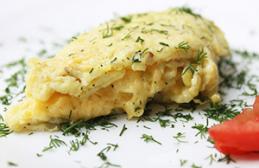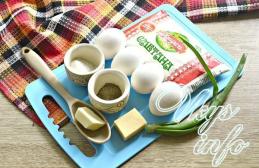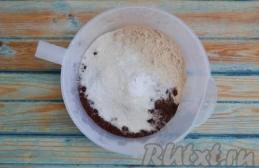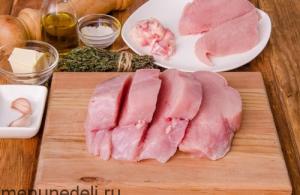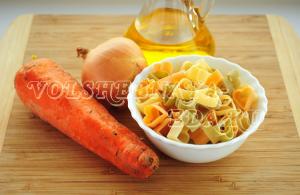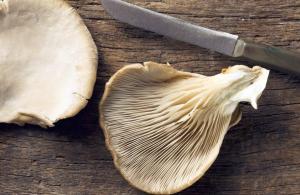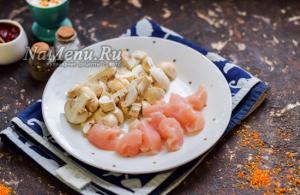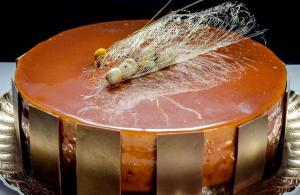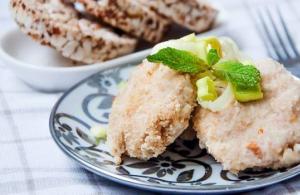The diet for pancreatitis is strict; you have to make do with a minimum of products. Get a full replenishment of the body with useful substances and at the same time be able to tolerate the taste of disgusting components. The pleasant variety that comes from introducing different salad options into your diet will help with this.
Principles of recipes
Of course, you won’t have to use the usual compositions. Salads for pancreatitis should include only approved products, so many ingredients often used in ordinary cuisine will have to be excluded.
To be sure that you can eat salad without scouring the Internet for substitutes, it is better to focus on personal taste and change your favorite dishes in accordance with the requirements of your diet. Then dietary changes are easier, food is more familiar, but the principles of gentle and healthy nutrition are observed. In this case, it is necessary to follow several general rules:
- Salads should be eaten only freshly prepared, in moderation. This is inconvenient, expensive and troublesome, but extremely necessary. Leaving portions in the refrigerator or eating excess so as not to throw it away is prohibited. Storage changes the properties of products, and excessive quantities increase the load on the digestive tract.
- Minimum seasonings, it is better to limit yourself to only a small amount of salt.
- The amount of fat should be limited, so yogurt, kefir, low-fat sour cream, a few drops of sunflower or olive oil can serve as dressings.
- It is desirable to heat treat all products; raw vegetables and fruits only from the permitted list in minimal quantities.
- When cutting, cubes the size of a match head are allowed, but it is better to use a meat grinder, blender or fine grater.
- To quickly cope with personal nutrition, when you need to cover the holiday table and there is a lot of work, you can use the basic ingredients of holiday salads in a more crushed form, replacing some of the prohibited products.
- It is better not to introduce products whose effect on a sick organism has not been previously tested into a salad, and certainly not to test several ingredients in salads at once. After all, then, in the event of an exacerbation, it is difficult to understand its cause.
Options for regular salads
Of course, the taste of the dishes will change if adjustments are made to them, but the opportunity for such variety is better than none at all. You can change any salad, but you need to be willing to accept its simplified taste.
The vinaigrette
They try to modify the well-known recipe in a variety of ways: soak cucumbers in water, replace them with sauerkraut. But soaked cucumbers do not contain any taste or nutrients, and sauerkraut is difficult to classify as a crushed food. Necessary:
- Boil carrots, potatoes and beets in their skins, and cook the beets for at least 2 hours.
- Peel the vegetables and chop finely.
- Also chop a peeled fresh cucumber and a little dill.
- A pinch of salt, a couple of drops of olive oil, and the salad is ready.
- Cucumber will refresh the taste, herbs and oil will add piquancy. Unusual, but edible.
Olivie
Prohibited foods definitely include mayonnaise, hard-boiled eggs, spices, pickled cucumbers and sausage or fatty meat. Therefore, we can offer several options for replacing them. All ingredients in approximately equal proportions:
- First option
- For those who like soft-boiled eggs, you can add them; the rest can easily do without eggs.
- Boil the chicken fillet and grind it in a meat grinder.
- Peel and grate a sweet apple, preferably a fragrant variety.
- Add a finely chopped sprig of parsley or basil, depending on the type of apple.
- Season with a pinch of salt and a spoonful of yogurt (not kefir, which is a little sour for this salad).
- Second option
- If you prefer spicier salads, you can:
- Boil carrots and potatoes in their skins, chop finely.
- Boil and chop the chicken fillet.
- Soft-boiled egg if desired.
- Finely grate a small portion of the sweet pepper, avoiding the skin. It is important to limit the quantity to a slice as the product is a little heavier than the others.
- For dressing, use salt, yogurt or kefir to taste.
- Third option
- It has a fishy taste, so it can only be consumed after a month of remission.
- Boil carrots and potatoes in their skins, chop finely.
- Boil lean fish fillet, remove bones and skin, chop.
- Grate mild and low-fat hard cheese on a fine grater.
- Finely chop a sprig of dill or parsley (to taste).
- Season with salt and yogurt.
Mimosa
Instead of canned fish, it is enough to take chopped boiled fillet and use fresh peeled cucumbers, grated.
Squirrel
- Option 1. Mix mild, low-fat hard cheese with finely chopped dill and 1 tbsp. l kefir.
- Option 2. For 100 gr. low-fat grated cottage cheese 1 tsp. finely chopped parsley. Season with salt and kefir.
Meat salads
In many salads, you can use boiled chopped chicken fillet as a base. This will help supply the body with useful substances and at the same time not gain excess weight:
- 1 option
- Small boiled chicken fillet, chopped.
- 1 tbsp. l. finely grated peeled zucchini.
- 1 tbsp. l. finely grated Adyghe cheese.
- Salt, yogurt for dressing, mix.
- Option 2
- Boil small chicken fillet and chop.
- Boil the pumpkin and chop it.
- Place in two heaps, pour over Adyghe cheese dressing, kefir and salt.
Fruit salads
It is permissible to use bananas, raspberries, apricots and plums, cherries, sweet varieties of apples and pears. Choose your favorite combination, rinse, pre-grate apples and pears, chop or chop bananas. Place in a bowl and top with a small amount of low-fat yoghurt.
It is important not to sprinkle sugar, because in combination with it, berries and fruits change their acidity to higher levels, which is bad for a sick body.
For pancreatitis, salad recipes should have an individual flavor. A lot depends on the body. During the period of remission, it is worth gradually adding foods to the diet and observing the reaction of the gastrointestinal tract. Some patients with pancreatitis calmly eat tomatoes, bake eggplants after soaking and add them to their menu. For others, it’s easier to add mint, green and blue basil, and celery. For some, even a sprig of parsley can create a problem. Therefore, recipes will have to be adjusted further, based not only on your preferences, but also on the course of the disease.
Salad is present on any everyday or holiday table. But when treating gastrointestinal diseases, patients have to reconsider their diet. Thus, lettuce leaves for pancreatitis are eaten in small quantities, because it contains various acids that irritate the intestinal mucosa and pancreas.
During the period of exacerbation of the pathology, therapeutic fasting is recommended, after which it is allowed to take gentle food. During remission, the diet can be enriched with various salads by selecting suitable ingredients. Below you can find out what salads are allowed to eat for pancreatitis, recipes and the beneficial properties of their components.
What greens are allowed?
If you have inflammation of the pancreas, you need to be careful when choosing ingredients for dishes. They can be very useful for healthy people, but when diagnosed with “acute or chronic pancreatitis,” on the contrary, they have a negative effect on the organs of the digestive system.
Lettuce is a common ingredient in green salads. The succulent leaves of the plant are rich in ascorbic acid, PP and B vitamins, iron, potassium, phosphorus, folic and citric acid. Despite all the usefulness of lettuce, it is allowed to be added to food when treating pancreatitis no more than twice a week.
As an alternative, you can use a dietary option containing the following ingredients:
- Potatoes – 3-4 pcs.
- Carrots – 2 pcs.
- Medium beets – 2 pcs.
Vegetables must be thoroughly washed and boiled with peel. The cooked products are cut into cubes and seasoned with sunflower oil. The vinaigrette is ready! You can eat it without fear, it saturates the body with active substances and satisfies the feeling of hunger.
Green salad is rich in beneficial micro- and macroelements, although it is taken in small quantities during pancreatic therapy. Only fresh vegetables should be added to it, for example, tomatoes, cucumbers, white cabbage and lettuce, pre-soaked in hot water. Such manipulations should be performed to reduce the content of ascorbic acid, which has a detrimental effect on the pancreas. You will also have to forget about garlic and green onions. Vegetable salad can be varied with parsley, dill or caraway seeds.
Mimosa salad in its traditional form cannot be eaten at any time. This is due to its composition: canned fish, carrots, eggs, onions, cheese, potatoes and mayonnaise. But if you exclude cheese, onions, egg yolks and mayonnaise, and also replace canned food with sea fish, and mayonnaise with low-fat sour cream, you will get a tasty and satisfying dish.
During the treatment period, you need to take foods that are easy for the digestive system. Therefore, during the treatment period, patients are prohibited from eating dishes such as Caesar, Crab Salad, Olivier, etc. It is worth remembering that special nutrition is the main condition for the successful recovery of every patient suffering from pancreatitis.
The beneficial and harmful properties of lettuce are discussed in the video in this article.
Inflammation of the pancreas is a serious condition called pancreatitis.
This pathology requires immediate treatment, which includes drug therapy and a special diet.
The diet of a sick person should contain only healthy and safe foods.
Periods of exacerbation require fasting for several days. After the specified time, you are allowed to eat only soft food.
Can patients eat salads with pancreatitis, and what different recipes are best to use? Read more about this.
Safe salads
Many people love to eat salads; they are used as main courses, served with fish and meat dishes, and prepared for a festive table.
Many of them are prepared from simple ingredients and consumed daily, while some are prepared from refined ingredients and served as delicacies.
Patients suffering from pancreatitis should not refuse tasty and healthy treats. The only condition is the correct ingredients.
All products contained in salads must be healthy and safe. They should not irritate the delicate mucous membrane of the pancreas and other digestive organs.
Useful components
Harmless salads for pancreatitis should contain exclusively healthy and safe food products.
All components must be natural, non-spicy, non-greasy, without smoked meats, excessive amounts of salt, flavors, dyes, preservatives and other harmful substances.
- Lean meats (veal, beef, chicken, turkey, rabbit).
- Low-fat fish varieties.
- Fruits and vegetables, steamed, baked, stewed, boiled.
- Sour cream and cottage cheese with low fat content.
- Vegetable oil.
All of these ingredients are very healthy and are recommended to be consumed both in salads and separately.
Harmful Ingredients
The pathological process is an irritation of the walls of the mucous membrane, which necessarily requires a gentle diet.
Some products can affect the speedy healing of the disease, while others can lead to an exacerbation of the disease.
Such products should not be eaten separately and should not be added to salads. Which ones exactly:
- Fatty meats (lamb or pork).
- Fatty fish.
- Fatty dairy products.
- Cheeses.
- Almost all types of nuts.
- Beans, beans, peas.
- Chicken egg yolks.
- Sauces and mayonnaise.
- Semi-finished products, various snacks, chips, crackers and other purchased products containing a high content of seasonings, spices, and harmful substances.
Many delicious salads that contain some harmful or prohibited foods in the recipe can be modified.
Taste qualities will not deteriorate from such changes. On the contrary, it will become unusual, but very useful.
Lettuce and spinach
In addition to permitted and prohibited products, there are those that stand on the border between them. These include lettuce and spinach leaves.
Both products are very useful because they contain a large amount of useful vitamins and important microelements.
This composition allows you to nourish the patient’s body with benefits and promote rapid recovery of the body.
In addition to being a storehouse of vitamins and minerals, spinach contains a rich supply of oxalic acid.
It has a detrimental effect on the inflamed pancreas, so it is recommended for fresh consumption as young leaves.
Lettuce leaves also contain vitamin complexes and beneficial elements. In addition, they contain a lot of ascorbic acid.
For these reasons, this product can only be eaten once or twice a week.
Recipes
The patient’s usual diet can be varied with healthy and safe salads.
All of them must be freshly prepared and contain as many healthy foods as possible.
Harmful components must be eliminated or replaced with more suitable ingredients.
Harmful mayonnaise, hot and sour sauces can be replaced with healthy natural yogurt, sour cream and low-fat kefir.
Any vegetable oils are relevant and useful. In some cases, dishes are seasoned with vegetable broth.
Before introducing new foods and dishes made from them, be sure to consult a doctor.
Only a gastroenterologist or nutritionist will be able to correctly select the set of permitted products or create a healthy and varied menu.
Beetroot salad
One of these dishes is considered to be beet salad. It is easy to prepare, does not require a significant number of complex ingredients, has a lot of benefits and excellent taste.
Preparing this dish is very simple. You will need to thoroughly rinse several beetroots under running water, boil them for 2 hours, peel them, finely chop them into strips, cubes or chop them on a coarse grater.
Add a little salt to the finished beet mixture, add finely chopped herbs, and season with vegetable oil.
The second version of this salad is a mixture of beets and carrots. In this case, both root vegetables are boiled in equal proportions, peeled, and crushed. For a more piquant taste, you can add one sweet apple.
Despite the beneficial composition of this salad, it is necessary to observe moderation when consuming it.
In addition to the rich composition of vitamins and minerals, it contains a significant amount of fiber that can load the affected organ. Therefore, it is important not to overdo it.
Olivie
The usual and traditional Olivier salad is prepared on the basis of vegetables, chicken fillet, peas and fatty mayonnaise.
For the dietary menu of a patient with pancreatitis, a lighter and healthier option is offered, which is in no way inferior in taste to the traditional one.
Initially, you should boil carrots, potatoes and eggs. Cool, peel. Boil chicken fillet in salted water until tender (you can use any other lean meat).
All boiled ingredients are crushed into cubes, a diced cucumber is added, which is previously peeled.
Remove the yolks from boiled eggs. They will not be needed when preparing the salad. Only proteins can be used.
You can add a little chopped herbs to the prepared mixture. Instead of the usual mayonnaise, you should use low-fat sour cream.
Such a salad will not only be tasty, but also very healthy, since it does not contain harmful components that can have a harmful effect on the inflamed pancreas.
The vinaigrette
This recipe is slightly different from the usual vinaigrette. But the taste is in no way inferior to the usual recipe, so it will be very useful for people suffering from pancreatitis.
In terms of its composition, it is also healthy, since it is prepared from vegetables. The diet menu requires a gentle diet, so this dish is prepared using several secrets.
Initially, prepare all the necessary products. You will need beets, carrots, and potatoes, which are thoroughly washed under running water and boiled in lightly salted water. Then cool, peel, and cut into cubes.
At this time, squeeze out all the juice from the sauerkraut and peel the pickled cucumber. Place the pickled vegetables in a separate bowl, then add a small amount of cool water and let it brew for half an hour.
Combine sauerkraut and diced cucumber with the main mass, season with a small amount of vegetable oil.
It is important to remember that dishes containing pickled vegetables are contraindicated for patients with exacerbation of pancreatitis.
This vinaigrette is allowed to be used only in chronic forms of the disease during periods of stable remission.
Mimosa
Traditional Mimosa is prepared from canned fish, boiled vegetables, cheese, and mayonnaise is used as a dressing.
The diet menu does not allow such a set of products, so an alternative recipe is offered.
First, cook vegetables: carrots and potatoes. Chicken eggs and pollock fillets (hake or other lean fish) are boiled in separate containers.
All vegetables and eggs are cooled and peeled. The finished fish is freed from bones and the fillets are prepared.
Start assembling the salad:
- The first layer is the fish. The fish fillet is disassembled into pieces, laying out the first layer on a dish.
- The second layer consists of boiled carrots. It is cut into small pieces (it is better to chop it using a coarse grater).
- Next, rub a small layer of lightly salted, mild, low-fat cheese.
- The yolks are separated from the eggs (they cannot be used), and the whites are grated on a coarse grater.
- The final layer will be potatoes grated on a coarse grater.
Instead of mayonnaise, low-fat sour cream is used to lubricate each layer. You can decorate the salad with finely grated yolk and sprigs of dill.
Mix salads
Vegetable and fruit lovers are invited to prepare several original recipes that include both components.
The combination of fruits and vegetables doubles the healing composition of the dish and gives an unusual taste.
Here are some examples:
- Wash carrots and sweet apples thoroughly. The carrots should be boiled, cooled, and peeled. Peel the apples, peel them from the seeds, and grate them using a coarse grater. Boiled carrots grated on a coarse grater are added to the apple mixture. Season the dish with low-fat yogurt, adding a few drops of natural bee honey.
- Wash and peel pumpkin, sweet apples, and melon. The pumpkin is cooked in a double boiler and cut into cubes. Peel the apples, remove the seeds, cut them into cubes, and add them to the pumpkin. The melon is peeled and seeds removed, cut into cubes, and added to the salad mixture. Low-fat yogurt with the addition of a few drops of natural bee honey is used as a dressing.
- An ideal breakfast or delicious dessert would be a dish made from pumpkin, bananas and peaches. All ingredients are thoroughly washed and peeled. The pumpkin is cooked in a double boiler, cooled, and cut into cubes. Peeled and chopped bananas and peaches are added to this mixture. Dress the salad with low-fat yogurt or low-fat sour cream.
All recipes are prepared solely to personal taste. The proportions can be anything, but it is recommended to use equal ratios.
Season with a small amount of dressing. Sugar and salt are kept to a minimum. Before introducing new salads into a patient’s diet, it is necessary to consult a specialist.
Some foods or dishes can be eaten during the chronic form of the disease, but are strictly prohibited during periods of exacerbation.
Useful video
When pathological processes form in the cavity of the digestive system, organs localized in the stomach, gall bladder, intestines, pancreas, or liver, the first thing patients have to do is completely reconsider their diet. During this process, you should completely exclude all products that can irritate the mucous surfaces of the digestive system, thereby causing an exacerbation of the resulting pathology. Cholecystitis and pancreatitis are those types of diseases for which diet becomes one of the most important steps on the path to recovery. Therefore, many are interested in what types of salads can be eaten with pancreatitis, so as not to harm their body.
Salads for pancreatitis should be prepared according to a special recipe, taking into account all the nuances of the prescribed diet. Those food products that are included in the list of prohibited foods for chronic pancreatitis, diabetes mellitus or cholecystitis are necessarily excluded from these dishes, and ingredients with a more gentle nature are selected for replacement, which will not pose a danger to the organ affected by inflammation.
What salads can you eat?
Any salads are considered one of the necessary attributes of both festive and everyday tables. During the period when the patient has a serious chronic disease of the parenchymal gland or an acute pancreatic process manifests itself, the consumption of any salads is completely excluded. After the onset of remission, the patient’s daily diet is expanded through the introduction of various vegetable salads, which must meet the following dietary requirements:
- salads should not contain any product from the list of prohibited products;
- the use of various seasonings and spices that create unusual notes of taste is not allowed;
- To dress salads, it is recommended to use vegetable or fruit sauce, as well as kefir, butter, sour cream or sauces.
Some of the popular salads for pancreatic disease are vinaigrette, salads based on chicken or Adyghe cheese, as well as Olivier salad and cucumber salad, but before preparing them you need to know which products are strictly prohibited for use in the development of an inflammatory process in the cavity of the parenchymal gland.
Prohibited Products
Let's take a closer look at the approximate list of prohibited products:
- all varieties of fatty fish and meat, especially lamb and pork;
- dairy products with high fat content;
- nuts and cheeses;
- sour foods;
- crab sticks;
- lettuce;
- all legumes, especially peas and beans;
- chicken egg yolk;
- mayonnaise sauce;
- flavored crackers and chips.
Based on this list of products that should be excluded from the usual salad recipes, patients have the opportunity to come up with new dishes by combining acceptable ingredients and creating a new unusual taste.

Leafy greens
Among the numerous variety of leafy greens, which are considered a real storehouse of useful substances, vitamins and microelements, there are those that are very often used for preparing salads, but at the same time they stand on the border between the list of permitted products for pancreatic disease and the list of prohibited spectrum products. This is due to the fact that these ingredients contain both useful components and dangerous substances for the affected parenchymal gland. Some of these types of greens are spinach and green lettuce.
Spinach leafy greens contain a huge amount of useful vitamin complexes and microelements. But besides this, it also contains oxalic acid, which causes irritation of the mucous surfaces of the parenchymal gland. Therefore, with the development of pancreatic pathology, doctors recommend using only fresh and young leaves of this vegetable for food.
Green salad can be eaten not only by healthy people, but also by patients with the development of pancreatic disease. But, since it contains a high concentration of ascorbic acid, it is recommended to eat it no more than 2 times a week.
Salad recipes for pancreatitis
Let's take a closer look at the most interesting recipes for delicious salads that can be prepared for any holiday and eaten during the development of pancreatic pathology on weekdays, without exceeding the limits of the dietary diet.
Olivie
Olivier is considered an essential attribute on the New Year's and Christmas tables, and it is also a pleasure to enjoy on weekdays.
- chicken egg yolk;
- mayonnaise;
- various spices;
- salted or pickled cucumbers;
- fatty varieties of meat or.
Therefore, the following simple recipe for preparing this dish is suitable as an excellent alternative for patients with a diseased pancreas:
- Carrots and potatoes are boiled in their skins until fully cooked, after which they are cooled, peeled and cut into cubes.
- Soft-boiled, they are separated from the yolk, after which the white is crushed and added to the chopped vegetables.
- Chicken breast or fillet is boiled, chopped with a knife or in a meat grinder and added to the salad.
- Then you need to separate the sweet apple from the peel and chop it, combine it with vegetables and meat, season it with a finely chopped sprig of parsley and add a spoonful of yogurt.
This salad will be an ideal addition to any holiday table and will be appreciated not only by adults, but also by children.

Dietary vinaigrette
Vinaigrette for pancreatitis prepared according to a traditional recipe is strictly prohibited for use. This is due to the fact that pickled or pickled cucumbers are usually added to its composition, which are acidic foods that are strictly prohibited in case of pancreatic pathology. Moreover, sauerkraut and legume vegetables are often added to this salad, which are also not recommended for this disease.
To prepare a dietary vinaigrette, you should cook equal proportions of beets, carrots and unpeeled potatoes. It is better to boil the beets in a separate pan, since it will take a lot of time to reach a state of complete readiness. Potatoes and carrots cook faster, so you can boil them in one container.
Peel everything and cut into cubes; you can season the salad with regular sunflower oil.

Beet salad
Beetroot is a very healthy root vegetable, which is included in the list of permitted foods for pancreatic disease. Its only disadvantage is its high concentration of fiber, so you can only eat it boiled or baked. The optimal cooking time for beets is two hours. You can cook it either in a regular saucepan with water, a slow cooker, or in a double boiler.
The essence of preparing homemade beet salad is that the finished vegetable is chopped using a coarse grater and seasoned with sunflower oil or sour cream with a low fat content.
It is also worth noting that boiled beets go well with boiled carrots, so the salad can be prepared from these two vegetables using the same technology. It is only important to remember that vinegar, as well as lemon juice and mayonnaise, are strictly prohibited from being used as a dressing for this salad by patients with pancreatic disease.

Diet "Mimosa"
Dietary meals for pancreatic disease are allowed to be consumed on a daily basis, provided that only food products permitted by the diet are used.
To prepare Mimosa, you need to first boil 3 chicken eggs. Then fish fillet, preferably pollock, is boiled for at least 20 minutes in the amount of 250 grams. one large carrot and three medium-sized potatoes are also boiled for 15-20 minutes.
Once all the ingredients are ready and have cooled slightly, you can begin to form the salad. Fish meat, cut into small pieces, is placed on the bottom of the plate. Then grated carrots are placed. The third layer is a small amount of grated cheese, which has a low fat content, on which grated protein is placed, and then potatoes, also passed through a coarse grater.
After laying, each layer is smeared with 10 percent fat sour cream. When finished, several sprigs of dill are carefully placed on potatoes greased with sour cream and the yolk is rubbed on a fine grater, thereby forming a beautiful sunny mimosa inflorescence, which is an extraordinary decoration for any table.

Cucumber salad
This salad is easy and quick to prepare. 100 grams of washed cucumbers are cut into rings, seasoned with vegetable oil and sprinkled with finely chopped dill.
You can use low-fat sour cream as a dressing for this salad. To do this, the cucumbers are thoroughly washed, peeled and cut into cubes. The whole thing is seasoned with sour cream and mixed thoroughly.

It is important to remember that fresh cucumbers are allowed to be consumed only during the period of stable remission of pancreatic disease.
Dietary salads with meat
Dietary salads can also be prepared based on low-fat varieties of meat, which include: beef, chicken and rabbit. As a complement to such dishes, you can use boiled vegetables, green salad leaves, as well as crackers made without any fats, seasonings and hot spices. Thanks to this, such salads will appeal to everyone’s taste and will not create any burden on the affected parenchymal organ.
Using this technology, you can prepare salads such as “Caesar”, “Greek” and “Iceberg”, but it is recommended to use them in limited quantities; if they are abused, the pancreas may become ill again, which will lead to aggravation of the pathological illness and the possible development of complications .
Bibliography
- GOST 4295--83. Fruits and vegetables are fresh. Sample selection.
- Shirokov E.P. Technology of storage and processing of vegetables with the basics of standardization. M. Agropromizdat 2008
- Nikolaeva M.A. Merchandising of fruits and vegetables. M. Economics 2006
- Gogulan M. Laws of adequate nutrition. Encyclopedia of health. publishing house AST Moscow 2009 pp. 127–141.
- Kazmin V.D. The healing properties of vegetables, fruits and berries with the application of original recipes for health improvement. Phoenix Publishing, 2007, pp. 32–53.
- Martynov S.M. “Vegetables + fruits + berries = health.” Publishing house Enlightenment, 1993, pp. 98–116.
Salad recipes for pancreatitis may differ from classic recipes. Ingredients that are potentially dangerous to the pancreas are necessarily excluded. They are replaced by gentle components that are safe during the inflammatory process. The diet for pancreatitis, contrary to misconceptions, is richly represented by various dishes. There was also room for salads on the menu of patients diagnosed with pancreatic disease.
What salads are possible for pancreatitis?
Salads are a worthy component of any menu, from everyday to festive. During an acute attack, of course, any salads are prohibited. But upon the onset of remission, the diet can be diversified by introducing vegetable salads that meet all the requirements of nutritionists:
- The ingredients must not contain prohibited products.
- Oils, Bechamel sauce, fruit or vegetable sauce, kefir, and sour cream are used as a dressing. Ketchup, soy sauce and mayonnaise are taboo.
- It is not advisable to add spices and herbs to give the dish an interesting taste.
For diseases of the pancreas, gastroenterologists allow vinaigrette, salad with squid and apples, chicken and Adyghe cheese, but with reservations.
Is it possible to use vinaigrette for pancreatitis?
A source of vitamins that replenishes deficiencies is vinaigrette. It can improve appetite, normalize food digestibility, and prevent constipation. Vinaigrette for pancreatitis is prepared according to a modified recipe. Surprisingly, this does not negatively affect the taste. On the contrary, the salad turns out tasty and juicy. You will need:
- Medium beet – 1 piece.
- Potatoes – 2 pieces.
- Barrel or pickled cucumber – 1 piece.
- Sauerkraut – 1 cup.
- Dill.
- Olive, vegetable or sunflower oil.
Boil the beets without adding salt for 90 minutes. Then drain the liquid and add cold running water. Boil the peeled potatoes for half an hour. Soak sauerkraut in cold boiled water for half an hour. This trick will help remove excess acid and salts. We also soak the cucumber cut in half for half an hour in cold water.
Meanwhile, cut the peeled beets into cubes. Place the vegetable in a container and add a small amount of vegetable oil. Mix thoroughly. Next, peel the cucumber, first rinsing it under water. After cutting into cubes, place in a salad bowl with the beets. Add washed and finely chopped dill to the salad. Only greens are used. We also cut the peeled potatoes into cubes. Wash the sauerkraut thoroughly and squeeze it out. Mix the ingredients. The vinaigrette is ready!
In case of chronic disease, salad is consumed in small portions, which should not exceed one hundred grams. In the weekly diet, vinaigrette is present once or twice. The dish is eaten fresh and warm. Chilled salad can harm the pancreas. In case of exacerbation and acute attack, salad is strictly prohibited.
Among the dangerous properties of lettuce for pancreatic disease are stimulation of secretion, irritating effect, increased swelling. Salts in the composition and coarse plant fiber can cause a new inflammatory process, therefore, for pancreatitis, vinaigrette is recommended only with the permission of the attending physician. The salad is introduced gradually, carefully monitoring the reaction of the gastrointestinal tract to the components.
Salad with squid and apples for pancreatitis
Compared to vinaigrette, squid salad with apples is more beneficial for pancreatitis. The simplicity of the recipe and exquisite taste make it a worthy representative of the daily and special menu.
Ingredients:
- Cleaned fresh frozen squids – 2 pieces.
- Chicken eggs – 2 pieces.
- Cheese – 100 grams.
- Sweet apple – 1 piece.
- Sour cream 10% fat – 5.5 tbsp.
- Salt.
The first step is to boil the carcasses. To do this, fill a container with water, put it on the fire, add some salt and wait for it to boil. Place the squid, turn down the burner, and boil for 2.5-3 minutes. We take out the boiled squid, transfer it to a plate and let it cool. Then cut them into rings.
Grate cheese without spices and mold on a coarse grater.
Boil chicken eggs hard for 7-12 minutes. After cleaning, grind on the coarse side of a grater.
We also chop the peeled apple using a coarse grater.
Mix the ingredients. Sour cream is suitable as a dressing. You can add a little salt for taste.
This salad contains easily digestible animal protein, vitamins (A and D), minerals (calcium, iodine and iron), and pectin.
The danger may lie in intolerance to sour cream and poor digestibility of chicken egg yolks. Therefore, introducing salad into the diet occurs gradually, starting with small portions. It is advisable to first make sure that no components cause attacks of the disease and are well tolerated by the body.
The high fat content of most ingredients, the acidity of the fruit and the density of the carcasses do not allow you to enjoy this salad during an acute illness or during an exacerbation of a chronic illness. This dish is allowed in cases of stable remission and long-term absence of symptoms.
The optimal frequency of use is once every two weeks. A serving should not exceed 125 grams.
Salad with chicken and Adyghe cheese for pancreatitis
For chronic pancreatitis, an extremely easy-to-prepare salad of chicken and Adyghe cheese, which supplies the body with animal protein, will help diversify the menu.
You will need:
- Half a chicken breast.
- Adyghe cheese – 100 grams.
- Dill greens – 50 grams.
- Low-fat sour cream or kefir – 2.5 tbsp.
- Salt.
Place the washed chicken breast in a container with water. After boiling, nutritionists recommend draining the liquid and adding new water. Cook for 30-40 minutes.
Wash the fresh dill well and chop finely.
Grind the cheese with your hands.
Cut the boiled chicken into small cubes.
All that remains is to add a little salt and season the salad with kefir or sour cream with a minimum percentage of fat content.
In the company of ingredients, the greatest danger is dill. The salad as a whole is famous for its good tolerance. It can be included in the diet with the consent of the treating doctor and subject to the tolerance of the products that make it up.



